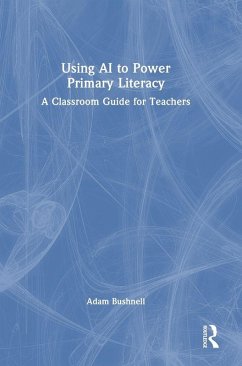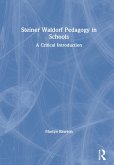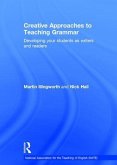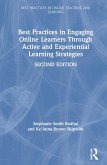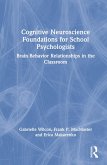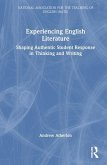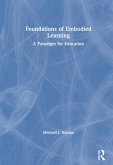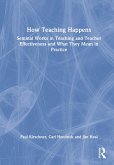- Gebundenes Buch
- Merkliste
- Auf die Merkliste
- Bewerten Bewerten
- Teilen
- Produkt teilen
- Produkterinnerung
- Produkterinnerung
Artificial intelligence (AI) is transforming the world around us and education is no exception. This practical guide demystifies AI for teachers, offering clear, accessible and practical strategies to enhance literacy teaching in a way that is both effective and engaging.
Andere Kunden interessierten sich auch für
![Steiner Waldorf Pedagogy in Schools Steiner Waldorf Pedagogy in Schools]() Martyn RawsonSteiner Waldorf Pedagogy in Schools150,99 €
Martyn RawsonSteiner Waldorf Pedagogy in Schools150,99 €![Creative Approaches to Teaching Grammar Creative Approaches to Teaching Grammar]() Martin IllingworthCreative Approaches to Teaching Grammar178,99 €
Martin IllingworthCreative Approaches to Teaching Grammar178,99 €![Best Practices in Engaging Online Learners Through Active and Experiential Learning Strategies Best Practices in Engaging Online Learners Through Active and Experiential Learning Strategies]() Stephanie Smith BudhaiBest Practices in Engaging Online Learners Through Active and Experiential Learning Strategies167,99 €
Stephanie Smith BudhaiBest Practices in Engaging Online Learners Through Active and Experiential Learning Strategies167,99 €![Cognitive Neuroscience Foundations for School Psychologists Cognitive Neuroscience Foundations for School Psychologists]() Gabrielle WilcoxCognitive Neuroscience Foundations for School Psychologists153,99 €
Gabrielle WilcoxCognitive Neuroscience Foundations for School Psychologists153,99 €![Experiencing English Literature Experiencing English Literature]() Andrew AthertonExperiencing English Literature171,99 €
Andrew AthertonExperiencing English Literature171,99 €![Foundations of Embodied Learning Foundations of Embodied Learning]() Mitchell J. NathanFoundations of Embodied Learning166,99 €
Mitchell J. NathanFoundations of Embodied Learning166,99 €![How Teaching Happens How Teaching Happens]() Paul KirschnerHow Teaching Happens168,99 €
Paul KirschnerHow Teaching Happens168,99 €-
-
-
Artificial intelligence (AI) is transforming the world around us and education is no exception. This practical guide demystifies AI for teachers, offering clear, accessible and practical strategies to enhance literacy teaching in a way that is both effective and engaging.
Produktdetails
- Produktdetails
- Verlag: Routledge
- Seitenzahl: 280
- Erscheinungstermin: 30. September 2025
- Englisch
- Abmessung: 250mm x 175mm x 20mm
- Gewicht: 667g
- ISBN-13: 9781041029069
- ISBN-10: 1041029063
- Artikelnr.: 74063442
- Herstellerkennzeichnung
- Libri GmbH
- Europaallee 1
- 36244 Bad Hersfeld
- gpsr@libri.de
- Verlag: Routledge
- Seitenzahl: 280
- Erscheinungstermin: 30. September 2025
- Englisch
- Abmessung: 250mm x 175mm x 20mm
- Gewicht: 667g
- ISBN-13: 9781041029069
- ISBN-10: 1041029063
- Artikelnr.: 74063442
- Herstellerkennzeichnung
- Libri GmbH
- Europaallee 1
- 36244 Bad Hersfeld
- gpsr@libri.de
Adam Bushnell is an award-winning author of fictional and academic books. He has had over fifty books published including Descriptosaurus: Story Writing and Modelling Exciting Writing. He works in the UK and internationally in both state and private education delivering creative writing workshops to all ages. Previously a teacher, Adam also delivers Continuous Professional Development to teachers on how to inspire reading and writing in the classroom.
PART 1
Reading Chapter 1
Personalised Texts and Reading Lists Chapter 2
Speech
to
Text Chapter 3
Phonics Chapter 4
Interactive Storytelling Chapter 5
Reading Fluency Chapter 6
Virtual Reading Buddies Chapter 7
Reading Games Chapter 8
Audiobooks Chapter 9
Simplifying and Extending Texts Chapter 10
Summarising Texts PART 2
Comprehension Skills Chapter 11
Quizzes Chapter 12
Key Moments Chapter 13
Vocabulary Expansion and Building Chapter 14
Emotion Analysis Chapter 15
Book Discussions Chapter 16
Reading Aloud to Avatars Chapter 17
Reading Challenges Chapter 18
Flashcards Chapter 19
Guess the Ending Chapter 20
Clarify the Confusion PART 3
Character Descriptions Chapter 21
Checking Book Character Descriptions Chapter 22
Character Analysis Chapter 23
Context of Characters Chapter 24
Appearance and Personality Chapter 25
Revealing Character Through Actions Chapter 26
Character Development Chapter 27
Sentence Starters Chapter 28
Opposites and Comparisons Chapter 29
Emotive Language Chapter 30
Dialogue PART 4
Setting Descriptions Chapter 31
Example Texts Chapter 32
Change the Timeline Chapter 33
Adding Sensory Detail Chapter 34
Developmental Prompts Chapter 35
Weather and Other Influences Chapter 36
Colour and Tone Chapter 37
Feedback on Descriptions Chapter 38
Movement Chapter 39
Other Worlds Chapter 40
Contrasting Places PART 4
Poetry Chapter 41
Explaining Literary Devices Chapter 42
More Figurative Language Chapter 43
Writing Ballads Chapter 44
Structured Poetry Chapter 45
Free Verse Chapter 46
Poetry Prompts Chapter 47
Rhyme Chapter 48
Thematic Ideas Chapter 49
Collaborative Ideas Chapter 50
Poetry Analysis PART 5
Non
Fiction Chapter 51
Structure Chapter 52
Research Chapter 53
Captions and Headings Chapter 54
Lesson Planning Chapter 55
Topic Related Vocabulary Chapter 56
Fact vs Opinion Chapter 57
Summarising Chapter 58
Explaining Features Chapter 59
Creating Narrative Non
Fiction Chapter 60
Writing Conclusions
Reading Chapter 1
Personalised Texts and Reading Lists Chapter 2
Speech
to
Text Chapter 3
Phonics Chapter 4
Interactive Storytelling Chapter 5
Reading Fluency Chapter 6
Virtual Reading Buddies Chapter 7
Reading Games Chapter 8
Audiobooks Chapter 9
Simplifying and Extending Texts Chapter 10
Summarising Texts PART 2
Comprehension Skills Chapter 11
Quizzes Chapter 12
Key Moments Chapter 13
Vocabulary Expansion and Building Chapter 14
Emotion Analysis Chapter 15
Book Discussions Chapter 16
Reading Aloud to Avatars Chapter 17
Reading Challenges Chapter 18
Flashcards Chapter 19
Guess the Ending Chapter 20
Clarify the Confusion PART 3
Character Descriptions Chapter 21
Checking Book Character Descriptions Chapter 22
Character Analysis Chapter 23
Context of Characters Chapter 24
Appearance and Personality Chapter 25
Revealing Character Through Actions Chapter 26
Character Development Chapter 27
Sentence Starters Chapter 28
Opposites and Comparisons Chapter 29
Emotive Language Chapter 30
Dialogue PART 4
Setting Descriptions Chapter 31
Example Texts Chapter 32
Change the Timeline Chapter 33
Adding Sensory Detail Chapter 34
Developmental Prompts Chapter 35
Weather and Other Influences Chapter 36
Colour and Tone Chapter 37
Feedback on Descriptions Chapter 38
Movement Chapter 39
Other Worlds Chapter 40
Contrasting Places PART 4
Poetry Chapter 41
Explaining Literary Devices Chapter 42
More Figurative Language Chapter 43
Writing Ballads Chapter 44
Structured Poetry Chapter 45
Free Verse Chapter 46
Poetry Prompts Chapter 47
Rhyme Chapter 48
Thematic Ideas Chapter 49
Collaborative Ideas Chapter 50
Poetry Analysis PART 5
Non
Fiction Chapter 51
Structure Chapter 52
Research Chapter 53
Captions and Headings Chapter 54
Lesson Planning Chapter 55
Topic Related Vocabulary Chapter 56
Fact vs Opinion Chapter 57
Summarising Chapter 58
Explaining Features Chapter 59
Creating Narrative Non
Fiction Chapter 60
Writing Conclusions
PART 1
Reading Chapter 1
Personalised Texts and Reading Lists Chapter 2
Speech
to
Text Chapter 3
Phonics Chapter 4
Interactive Storytelling Chapter 5
Reading Fluency Chapter 6
Virtual Reading Buddies Chapter 7
Reading Games Chapter 8
Audiobooks Chapter 9
Simplifying and Extending Texts Chapter 10
Summarising Texts PART 2
Comprehension Skills Chapter 11
Quizzes Chapter 12
Key Moments Chapter 13
Vocabulary Expansion and Building Chapter 14
Emotion Analysis Chapter 15
Book Discussions Chapter 16
Reading Aloud to Avatars Chapter 17
Reading Challenges Chapter 18
Flashcards Chapter 19
Guess the Ending Chapter 20
Clarify the Confusion PART 3
Character Descriptions Chapter 21
Checking Book Character Descriptions Chapter 22
Character Analysis Chapter 23
Context of Characters Chapter 24
Appearance and Personality Chapter 25
Revealing Character Through Actions Chapter 26
Character Development Chapter 27
Sentence Starters Chapter 28
Opposites and Comparisons Chapter 29
Emotive Language Chapter 30
Dialogue PART 4
Setting Descriptions Chapter 31
Example Texts Chapter 32
Change the Timeline Chapter 33
Adding Sensory Detail Chapter 34
Developmental Prompts Chapter 35
Weather and Other Influences Chapter 36
Colour and Tone Chapter 37
Feedback on Descriptions Chapter 38
Movement Chapter 39
Other Worlds Chapter 40
Contrasting Places PART 4
Poetry Chapter 41
Explaining Literary Devices Chapter 42
More Figurative Language Chapter 43
Writing Ballads Chapter 44
Structured Poetry Chapter 45
Free Verse Chapter 46
Poetry Prompts Chapter 47
Rhyme Chapter 48
Thematic Ideas Chapter 49
Collaborative Ideas Chapter 50
Poetry Analysis PART 5
Non
Fiction Chapter 51
Structure Chapter 52
Research Chapter 53
Captions and Headings Chapter 54
Lesson Planning Chapter 55
Topic Related Vocabulary Chapter 56
Fact vs Opinion Chapter 57
Summarising Chapter 58
Explaining Features Chapter 59
Creating Narrative Non
Fiction Chapter 60
Writing Conclusions
Reading Chapter 1
Personalised Texts and Reading Lists Chapter 2
Speech
to
Text Chapter 3
Phonics Chapter 4
Interactive Storytelling Chapter 5
Reading Fluency Chapter 6
Virtual Reading Buddies Chapter 7
Reading Games Chapter 8
Audiobooks Chapter 9
Simplifying and Extending Texts Chapter 10
Summarising Texts PART 2
Comprehension Skills Chapter 11
Quizzes Chapter 12
Key Moments Chapter 13
Vocabulary Expansion and Building Chapter 14
Emotion Analysis Chapter 15
Book Discussions Chapter 16
Reading Aloud to Avatars Chapter 17
Reading Challenges Chapter 18
Flashcards Chapter 19
Guess the Ending Chapter 20
Clarify the Confusion PART 3
Character Descriptions Chapter 21
Checking Book Character Descriptions Chapter 22
Character Analysis Chapter 23
Context of Characters Chapter 24
Appearance and Personality Chapter 25
Revealing Character Through Actions Chapter 26
Character Development Chapter 27
Sentence Starters Chapter 28
Opposites and Comparisons Chapter 29
Emotive Language Chapter 30
Dialogue PART 4
Setting Descriptions Chapter 31
Example Texts Chapter 32
Change the Timeline Chapter 33
Adding Sensory Detail Chapter 34
Developmental Prompts Chapter 35
Weather and Other Influences Chapter 36
Colour and Tone Chapter 37
Feedback on Descriptions Chapter 38
Movement Chapter 39
Other Worlds Chapter 40
Contrasting Places PART 4
Poetry Chapter 41
Explaining Literary Devices Chapter 42
More Figurative Language Chapter 43
Writing Ballads Chapter 44
Structured Poetry Chapter 45
Free Verse Chapter 46
Poetry Prompts Chapter 47
Rhyme Chapter 48
Thematic Ideas Chapter 49
Collaborative Ideas Chapter 50
Poetry Analysis PART 5
Non
Fiction Chapter 51
Structure Chapter 52
Research Chapter 53
Captions and Headings Chapter 54
Lesson Planning Chapter 55
Topic Related Vocabulary Chapter 56
Fact vs Opinion Chapter 57
Summarising Chapter 58
Explaining Features Chapter 59
Creating Narrative Non
Fiction Chapter 60
Writing Conclusions

